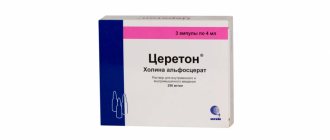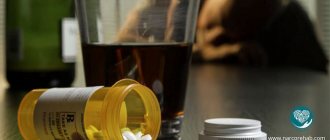The active substance of the drug is loperamide hydrochloride, an antidiarrheal agent. The drug is available in several forms for oral administration:
- tablets: odorless, white, round, scored, dosage 2 mg, packaged in blisters of 10 pieces;
- capsules: elongated, with an opaque shell of gray and yellow colors, inside they contain white powder with active and auxiliary components.
Form-forming and stabilizing additives of the drug: silicon dioxide, starch, lactose, talc, magnesium salts, gelatin, dyes. Lopedium cardboard packaging contains 1–5 blisters of 10 tablets or capsules.
Pharmacodynamics and pharmacokinetics
Loperamide is a synthetic derivative of piperidine . It acts on peripheral opioid receptors , reducing the production of acetylcholine and prostaglandins . Thus, the propulsive peristalsis of the small intestine decreases, bowel movements occur with less frequency, and the feces acquire a harder consistency.
Indications for use of the drug are frequent bouts of diarrhea. This is due to the ability of the drug to increase the tone of the anal sphincter and reduce the frequency of bowel movements.
After taking the tablets, they quickly enter the bloodstream after being absorbed into the gastrointestinal tract . 4-5 hours after administration, loperamide reaches its maximum concentration in the blood plasma and, in a fairly small amount, can penetrate the blood-brain barrier .
It undergoes metabolic reactions in the liver, is excreted after 9-14 hours in the feces, and a small amount is excreted through the kidneys.
Due to the fact that the drug is metabolized in the liver, consultation with a doctor and dose adjustment for patients with liver disease is required.
How does Lopedium work?
Loperamide dissolves in the intestinal lumen, increases the viscosity of feces, reduces water absorption, and reduces the tone of muscle walls. The mechanism of action is based on the effect of the drug on specific receptors that regulate peristalsis. As a result of taking the drug, the time it takes for food masses to pass through the gastrointestinal tract increases, and attacks of diarrhea stop or become less frequent.
After taking a dose of the medication, its effect increases and lasts about 6 hours. The effect occurs after the first capsules (tablets): the urge to defecate decreases. Lopedium components are transformed under the influence of bile acids. Most of the metabolites are excreted in feces, and a small part is excreted in urine. The drug acts predominantly in the intestinal space, a small amount of it penetrates into the systemic bloodstream. The remedy for diarrhea does not lead to intoxication of the body and does not accumulate in tissues. Complete elimination of its residues occurs within 19–24 hours after administration.
Indications for use
The drug can be prescribed for any type of diarrhea .
Lopedium - what are these pills for?
- treatment of chronic, allergic, emotional, medicinal and radiation diarrhea;
- an additional remedy for the treatment of infectious diseases of the gastrointestinal tract (together with antibiotics );
- diarrhea caused by a change in diet, metabolic disorders, and certain gastrointestinal tract ;
- elimination of diarrhea during ileostomy .
Lopedium tablets - for what else?
An indication for the use of the drug may also be digestive disorders in tourists ( traveler's diarrhea ). Capsules can be taken for 2 days. If blood appears in the stool, you should consult a doctor.
Use of the drug Lopedium
For acute and chronic diarrhea, the initial dose is 2 capsules for adults and 1 capsule for children aged 5 years and older; in the future, 1 capsule is prescribed after each subsequent liquid bowel movement. For chronic diarrhea, the maintenance dose is 1 capsule 1-2 times a day. The maintenance dose is selected so that the frequency of bowel movements is 1–2 times a day. The maximum daily dose for acute and chronic diarrhea is no more than 8 capsules for adults and 3 capsules per 20 kg of body weight for children. Capsules should be swallowed without chewing, with a small amount of liquid. After normalization of stool or in the absence of bowel movements for 12 hours, the drug is discontinued. If in acute diarrhea 48 hours after the start of treatment there is no clinical improvement, treatment with the drug should be discontinued and treatment tactics should be reconsidered.
Contraindications
- severe allergic reactions to the components of the drug;
- acute dysentery (blood in stool, fever);
- age up to six years;
- bacterial enterocolitis ( salmonellosis, shigellosis );
- acute colitis caused by taking antibiotics ;
- In the process of using the product, bloating , constipation , and intestinal obstruction .
Side effects
Possible:
- headache, tremor, drowsiness and loss of consciousness ;
- urinary retention, miosis;
- constipation, nausea, indigestion, megacolon;
- Stevens-Johnson syndrome , angioedema , itchy skin and urticaria .
Lopedium, instructions for use (Method and dosage)
Capsules are taken whole, do not bite, and washed down with water.
According to the instructions for use of Lopedium, it can be prescribed to adults and children starting from the age of six.
For adults, with chronic or acute diarrhea, the initial dosage is 4 mg, after each trip to the toilet (defecation). Then the dosage can be reduced to 2 mg. The maximum drug taken per day is 16 mg.
For children, 2 mg is initially prescribed, with a maximum of 6 mg per day.
The course of treatment ends upon reaching a state where the time between two bowel movements is at least 12 hours.
Lopedium
Lopedium ®
(
Lopedium
) is an antidiarrheal drug, a high-quality generic version of loperamide.
Composition and release form of lopedium
The active ingredient of Lopedium is loperamide. Lopedium is available in the following dosage forms:
- 2 mg tablets
, white, one tablet contains 2 mg loperamide hydrochloride - gelatin capsules 2 mg
, capsule body - gray, cap - dark green, one capsule contains 2 mg of loperamide hydrochloride
Excipients:
- common for tablets and capsules: lactose monohydrate, magnesium stearate, corn starch
- only in tablets: calcium hydrogen phosphate dihydrate, sodium starch glycolate, colloidal silicon dioxide
- only in capsules: talc, gelatin, black iron oxide (E172), blue dye (E131), titanium dioxide (E171)*.
Indications for use of Lopedium
- acute and chronic diarrhea due to allergic, emotional, medicinal and radiation in nature
- diarrhea due to changes in diet and diet
- diarrhea due to impaired absorption and metabolism
- infectious diarrhea - only as an adjuvant
- regulation of stool in patients with ileostomy.
Contraindications to the use of Lopedium
- hypersensitivity to the components of the drug
- intestinal obstruction
- acute ulcerative colitis, diverticulosis
- diarrhea due to pseudomembranous enterocolitis
- acute dysentery, especially with blood in the stool and accompanied by fever
- other gastrointestinal tract infections caused by salmonella, shigella, campylobacter and other pathogens
- tablets - up to two years
- capsules - up to six years
Method of application of Lopedium and dose
Lopedium tablets and capsules are taken orally, without chewing, with water.
- children over 6 years old take 2 mg of Lopedium after each loose stool, but not more than 6 mg per day
- adults initially - 4 mg Lopedium, then 2 mg after each loose stool, but not more than 16 mg per day
After the cessation of diarrhea, normalization or absence of bowel movements, the use of Lopedium is stopped.
Use of Lopedium by pregnant, nursing mothers and young children
The use of Lopedium by pregnant women is not recommended. FDA fetal risk category for loperamide in pregnant women is “C” (animal studies have shown adverse effects on the fetus and there have been no adequate studies in pregnant women, but the potential benefits associated with the use of this drug in pregnant women may justify it use despite the risk). Loperamide passes into breast milk in small quantities, so breastfeeding is not recommended when mothers are treated with Lopedium.
WHO position on the use of loperamide in the treatment of diarrhea in children
WHO training manual “Treatment of diarrhea” (2006) Fr.
Side effects of Lopedium
During therapy with Lopedium, the following are possible: abdominal pain, dry mouth, nausea, vomiting, intestinal colic, constipation, drowsiness or insomnia, dizziness, headache, skin rash, and very rarely, intestinal obstruction.
general information
Lopedium is an over-the-counter medicine.
During therapy with Lopedium, caution must be exercised when driving vehicles and other similar activities.
According to the pharmacological index, Lopedium belongs to the group “Antidiarrheals”. For ATC - to the group “Drugs that reduce gastrointestinal motility”, code A07DA03.
Other medicines with the active ingredient loperamide: Vero-Loperamide, Diara, Diarol, Imodium, Laremid, Loperacap, Loperamide, Loperamide Grindeks, Loperamide Stada, Loperamide-Acri, Loperamide hydrochloride, Superilop, Enterobene.
The manufacturer of Lopedium is Hexal AG (Hexal, AG), Germany.
On the website GastroScan.ru in the “Literature” section there are subsections “Laxatives” and “Constipation and Diarrhea”, containing articles for healthcare professionals on this topic.
* In the EU, from 2022, by decision of the European Food Safety Authority (EFSA), the use of titanium dioxide (E171) in food is completely prohibited, as this food additive is no longer considered safe.
Lopedium has contraindications, side effects and application features; consultation with a specialist is necessary. Back to section
Overdose
Symptoms of overdose are severe depression of the central nervous system , including urinary retention, intestinal obstruction , severe depression of the central nervous system , stupor , miosis , convulsions . It should be remembered that children are more sensitive to the drug than adults.
Naloxone is a specific antidote for the drug. Repeated administration of the antidote may be necessary. of enterosorbents should not be excluded .
Special instructions for the use of the drug Lopedium
The use of the drug does not exclude the prescription of antibacterial therapy and rehydration according to indications. The metabolism of loperamide is slowed in patients with liver disease. In children aged 5–6 years, the administration of the drug requires constant medical supervision. The drug should not be prescribed for a period of more than 4 weeks without the possibility of repeated medical examination. Despite the lack of data on the teratogenic and embryotoxic properties of the drug, loperamide can be prescribed during pregnancy, especially in the first trimester, only if the expected therapeutic effect outweighs the potential risk to the fetus. Lopedium does not affect the ability to work with equipment, however, if increased fatigue, drowsiness or dizziness occurs, it is not recommended to engage in such activities.
Lopedium price, where to buy
The price of Lopedium is about 40 rubles for 10 tablets.
- Online pharmacies in RussiaRussia
- Online pharmacies in UkraineUkraine
ZdravCity
- Lopedium tablets 2 mg 10 pcs. Salutas Pharma GmbH
56 rub. order - Lopedium capsules 2 mg 10 pcs. Salutas Pharma GmbH
28 RUR order
Pharmacy Dialogue
- Lopedium (2 mg tablet No. 10) Salutas Pharma GmbH
59 RUR order
- Lopedium (caps. 2 mg No. 10) Salutas Pharma GmbH
30 rub. order
show more
Pharmacy24
- Lopedium 2 mg No. 10 capsules Salutas Pharma GmbH, Nimechchina / Lek S.A. Poland
45 UAH. order









